It was well after midnight and into the wee hours of March 13 in suburban New Jersey, when Jets GM Joe Douglas saw agent David Dunn’s number flash on his phone. The free-agent tampering period was set to begin in a matter of hours, at noon that Monday. Pro day season was underway, too. But there was nothing more important, in the moment, for Douglas, or for the Jets, than answering that call.
“Hey, man, I know it’s late out there,” said Dunn, calling on behalf of his star client. “Aaron wants to be a Jet.”
Aaron, of course, was Aaron Rodgers, and Douglas’s reaction was like Jonah Hill’s portrayal in Moneyball of analytics legend Paul DePodesta (renamed Peter Brand in the movie) finalizing the Ricardo Rincon deal crossed with Leonardo DiCaprio’s Jordan Belfort closing a sale in The Wolf of Wall Street. Yes, the Jets’ GM wanted to scream in exultation. But his kids and wife were sleeping, so all the fist pumps and skipping around the room had to happen in silence.
And happen they did.
Douglas first texted his coach, Robert Saleh, and team president, Hymie Elhai, to let them know—in all caps—that they were going to wake up to the best news they’d ever gotten. Douglas then poured himself a glass of Blanton’s single-barrel bourbon whiskey on the rocks. He turned on the TV. He couldn’t get to sleep until 3 a.m., his mind racing through all that would come in the aftermath of Dunn’s simple message.
Most of all, he thought, No one on the f---ing planet knows what’s going on here.
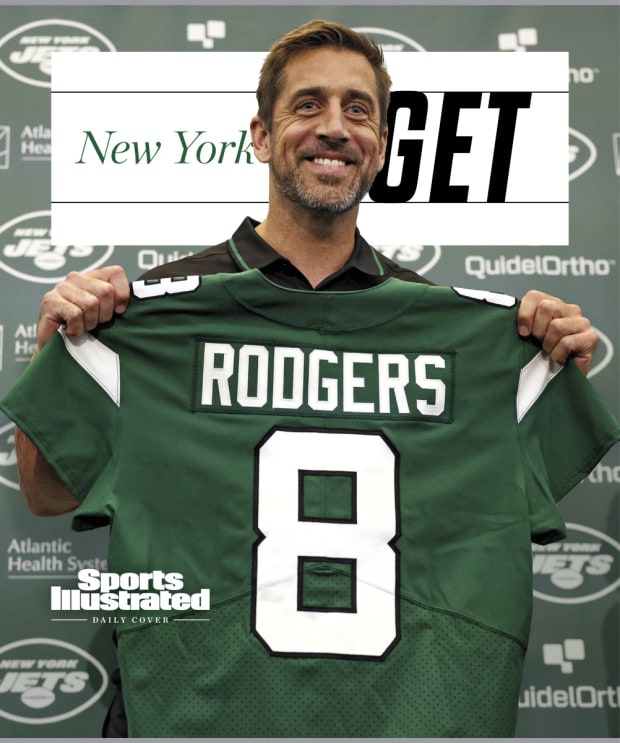
Elsa/Getty Images
What Douglas knew, at that point, was that Rodgers would be a Jet. It’d sink in for Saleh fewer than 72 hours later, when the coach watched, from Douglas’s office, as Rodgers delivered the news they’d already gotten to the masses on The Pat McAfee Show. “Since Friday,” Rodgers said. “I made it clear that my intention was to play, and my intention was to play for the New York Jets.”
What remained was actually executing the trade, and the process of doing that, for both teams, was underway as well, if (as it turned out) only in its nascent stages.
Through the six weeks to follow, there were ups and downs, and fits and starts, and a lot of speculation on whether the deal would, in fact, get done. And lots of questions from the outside about how the biggest news story of the NFL offseason would find its conclusion, and whether, based on the lag time, it could all fall apart.
The truth was, for Douglas and Saleh, there was never any doubt. Or really any choice. They had to get it done, and, indeed, 42 days after Douglas danced silently around his house and celebrated with that pricey glass of bourbon, it did get done.
The story of the Rodgers trade goes back further than Jan. 8, but it was on that Sunday that the wheels started turning, with the season, for both teams, ending in crash landings.
That afternoon, the Jets lost their sixth consecutive game, to finish what was once a promising season—at 5–2, 6–3 and 7–4—at 7–10 and with a mess at quarterback looming as the culprit for the collapse. A few hours later, the Packers—their chips pushed into the middle of the table on an aging, veteran core—lost a 20–16 heartbreaker to the Lions, a defeat that snapped a four-game winning streak and kept Green Bay out of the playoffs for the first time in Matt LaFleur’s four seasons as coach.
Coming out of it, mandates for both Douglas and Packers GM Brian Gutekunst were clear.
The former had to find a quarterback. The latter would have to make a decision about whether to continue on the aggressive, win-now path that his incumbent quarterback helped carve. And that was reflected in the exit meetings the teams had with their respective QBs. The Jets told 2021 No. 2 pick Zach Wilson they’d explore adding an experienced veteran at his position (Wilson accepted it at first, and would be excited later, when finding out his idol would be that vet).
Meanwhile, in the couple of days after their year fizzled out with that Week 18 loss, the Packers reviewed the season with Rodgers, and Rodgers told them he wanted some time to mull over his future—with his 40th birthday less than a year away.
Fantasy: Here’s What to Expect From Aaron Rodgers in 2023
From there, Green Bay’s brass went into personnel meetings to assess the roster and set out a plan for 2023. After two years of mortgaging contracts to keep the team together and pursue a second Lombardi Trophy with Rodgers, the Packers were overleveraged on the salary cap. And unlike the two seasons before, back-to-back 13-win campaigns, they finished the regular season in the middle of the NFL, not at the top of it—with big, overarching questions looming.
Should we be turning over the roster? Should we be letting our younger guys play?
Everyone in the room knew the bigger implication of making such decisions. Whether it was said explicitly or not, the players they were talking about—guys like receiver Randall Cobb and tight ends Robert Tonyan and Marcedes Lewis—were players Rodgers was closest to, and guys Rodgers liked having around, guys he felt enhanced his performance simply by having him in the right place mentally. Which meant that saying goodbye to those players could mean saying goodbye to Rodgers, too.
And making the prospect of that even more real was the progress that Rodgers’s understudy, 2020 first-rounder Jordan Love, was making.
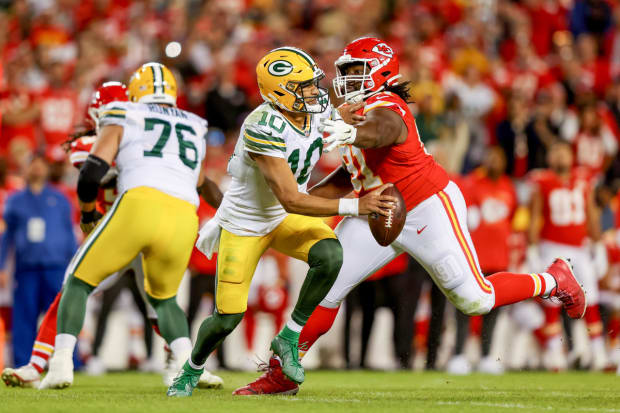
Jamie Squire/Getty Images
Green Bay’s previous doubts about Love had slowly been melting away. They were impressed by how he handled starting against the Chiefs in 2021—they loved how he was able to jump in on two days’ notice, handle an unexpected barrage of zero blitzes from Kansas City, endure the physical beating it led to and keep his head about him through a resulting rough start to that game. He’d made progress with his presnap and postsnap command in camp in ’22, and with having his eyes in the right places, too, and ascended with six weeks of first-team practice reps while Rodgers managed a broken thumb in the fall.
That gave the Packers a viable alternative, and flexibility as a result, as Gutekunst went to relay their objective to Rodgers to clean up the cap and get younger in 2023, a plan he figured the 18-year veteran might not want to be a part of. The problem, from there, was getting time with the quarterback.
The two set up a Wednesday meeting in Los Angeles in late January while Gutekunst was in town for the NFLPA Collegiate Bowl. That one didn’t happen. Gutekunst had to go to Las Vegas the next day for the East-West Shrine Bowl, and the idea that he could return from there to California to meet Rodgers was broached. But that didn’t happen, either, making the exit meeting the last time they’d talked.
Meanwhile, just before then, Gutekunst quietly started to gauge interest in Rodgers from people he trusted with other teams, careful both in whom he talked to and how he phrased the question. It went something like this—I don’t know if he’s going to play or retire, or play with us or someone else, but just so I know, if he wants to move on, would you be interested?
Douglas, at that point in January, was the one person to raise his hand and say yes.
The Jets had been through their own meetings. Saleh, in person and over Zoom, had interviewed 22 candidates for his offensive coordinator spot and, once that was done, had the coaches study all the free-agent or potentially available quarterbacks—with Derek Carr, Jimmy Garoppolo and Ryan Tannehill atop the list, and the revamped Jets staff having connections to all three of them.
Of course, perhaps the strongest connection of all would be to a quarterback at whom Douglas and personnel-side lieutenants Rex Hogan, Chad Alexander and Greg Nejmeh at first took only a cursory look. (They’d actually hatched the plan to pursue a vet, and started studying the others, right after the Jets were eliminated from the playoff race on Jan. 1.)
Saleh’s coordinator hire, former Broncos coach Nathaniel Hackett, had coached Rodgers for three years in Green Bay and gotten incredibly close to the Packers’ quarterback. Hackett’s hire, to be sure, was made on the coach’s merit—Saleh sold him on not taking a year off on Denver’s dime, and Douglas was fully on board after sitting in on the interview. But having a buddy of Rodgers’s on hand surely didn’t hurt.
So, yes, the Jets were interested, and getting more interested by the day.
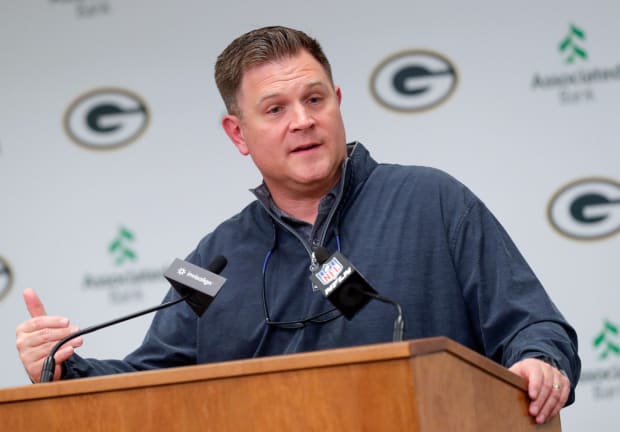
Sarah Kloepping/USA TODAY Network
With Rodgers deliberating, and contemplating his future during his famed darkness retreat, Douglas and Gutekunst started the feeling-out process on the parameters of a trade, with discussions picking up at the combine in Indianapolis. If anything was clear, it was that there was work to be done.
The Packers initially wanted a return in the neighborhood of what Detroit got for Matthew Stafford in 2021 (two firsts and a third). The Jets didn’t want to give up a single first-round pick, let alone two, given that they had no assurances Rodgers would play more than a year. And both organizations were led by men—Jets owner Woody Johnson and Packers president Mark Murphy—who were part of, and marked by, the last blockbuster quarterback deal made between these two franchises.
Both, to be fair, had reason to feel spurned by the 2008 Brett Favre transaction. The Packers, in that one, acquired a pick heavy on conditions. Favre hit a play-time marker to take it from a fourth-round pick to a third, but a late-season injury kept Green Bay from getting a second (the Jets would’ve had to make the playoffs to trigger that) or first (they would’ve needed to make the Super Bowl). Also, they put in a provision that the Jets would send Green Bay three No. 1 picks if Favre was traded to the Vikings. The Jets cut him, and Favre got to Minnesota anyway.
The Jets, on the other side of it, got only a single year out of Favre and lost a year of a championship window for the rest of the roster because of the injury.
But none of that gave Rodgers any reason not to forge ahead. Failing to talk directly with Rodgers, Gutekunst had begun to work directly with Dunn on the situation and communicated the Jets’ interest, while emphasizing that if there was going to be a split, the Packers wanted it to be cordial. Dunn agreed and near the end of the combine got back to Gutekunst with an answer.
Rodgers wanted to be a Jet.
Douglas got back to Jersey from Indianapolis on March 5. That night, Gutekunst called Douglas. It looks like Aaron wants to explore an opportunity with you guys, Gutekunst told Douglas. We’re gonna give you permission to talk to him.
The Jets GM immediately called Saleh and Elhai, and the three agreed to meet that Monday morning, March 6, to map out the rest. They’d heard Rodgers just left New York to go home to California and they weren’t going to ask him to fly back cross-country. So they’d resolved to ask Rodgers whether they could come to him in California on March 7. Rodgers agreed, and Elhai booked a private jet to take him, Douglas, Saleh and Hackett from the Morristown airport to the Camarillo airport, just north of Rodgers’s home in Malibu. Meanwhile, Johnson would fly in from Florida and his brother, Jets vice chairman Christopher Johnson, would fly in from Colorado.
The plane carrying the contingent coming from Jersey battled 150-mph headwinds all the way to California, leaving them almost an hour and a half behind schedule.
It was a small price to pay for the potential prize on the other end of the trip.

The Jets’ plan going into the meeting was, more or less, not to have a plan. Arriving at Rodgers’s place in the afternoon, with the Santa Monica Mountains as the backdrop and a pristine beach setting below, all they wanted was for the quarterback to get to know them better. Douglas brought an iPad, so if Rodgers wanted to see the Jets’ depth chart or cut-ups of his players, he could accommodate. That iPad was never put to use.
Meeting details would be kept quiet, outside of a couple of broad takeaways.
One was that the Jets left the summit with the idea that Rodgers wanted to play football in 2023—not based on anything he’d said, but the passion that was still so clearly there, how prepared he was in knowing the Jets’ roster and situation inside and out, and how he talked about teammates and coaches as they discussed a hypothetical plan. The other was that Dunn showed up with takeout, which, in a way, encapsulated the informal nature of the whole thing.
It lasted about four hours, into the Malibu night, and everyone left with good feelings, if not concrete answers on what was next. Rodgers had gotten time with everyone, and Hackett had actually kept his distance, at times, so the others would get to build a rapport with the guy he already knew so well. The Jets weren’t going to press Rodgers for an answer, and he wasn’t ready to give them one, so they thanked the quarterback and told him they hoped to talk again at the end of the week.
They left around 8 p.m. and went to get Mexican food near their hotel in Santa Monica. Over dinner, no one spoke in absolutes. But they all loved the person they’d met, independent from the fact that he was a Hall of Fame player. Which meant their excitement to actually acquire him had only been amped up.
They flew back Wednesday morning, and, two days later, on Friday night, Rodgers and Douglas had a follow-up conversation as the quarterback was headed to a charity flag football game in Orange County. Rodgers didn’t tip his hand. But by then, Douglas had heard that Rodgers would likely either retire or play for the Jets, and he continued to sound like a guy who was going to play.
The tricky part—at that point for the Jets—was balancing the strong desire to land Rodgers with the possibility that it wouldn’t happen, and what that might mean with other options likely to come off the table in the meantime.
Accordingly, fewer than 24 hours after Douglas and Rodgers had their follow-up conversation, Carr signed with the Saints. The longtime Raider, who visited the Jets in February and also had a strong connection to New York’s staff (he and new pass-game coordinator Todd Downing were together in Oakland), would have been the Jets’ primary target if not for Rodgers. With Carr signed and the legal tampering window fast approaching, the stakes were raised.
Then, Dunn’s call came.
More from Albert Breer: Why Lamar Jackson’s Deal Is a Step Up From Jalen Hurts’s | 2024 NFL Draft: The Six Players Fans Need to Know, Including Caleb Williams
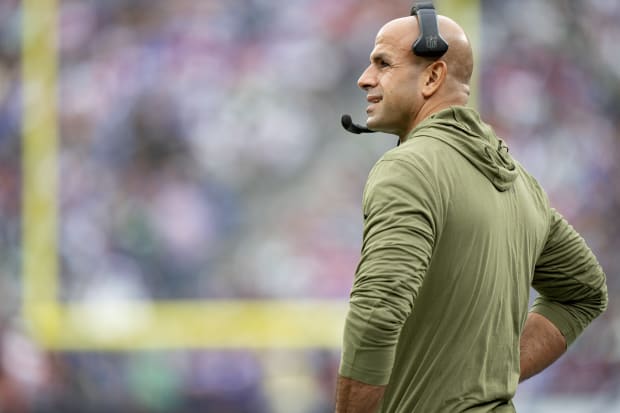
Erick W. Rasco/Sports Illustrated
The relationship between Saleh and LaFleur extends well beyond the playing fields of the NFL. The two got to know each other as low-level assistants under Brian Kelly at Central Michigan in 2004. They hit it off quickly. LaFleur was the best man at Saleh’s wedding. They worked together again in Houston, and Saleh worked with LaFleur’s little brother, Mike, in San Francisco, then hired Mike as offensive coordinator with the Jets (he’ll be the Rams’ OC in ’23).
So early on, Saleh called Matt LaFleur, knowing how these things can strain relationships and having seen that firsthand, and said to his friend, Hey buddy, let’s just not talk about this.
They were disciplined about it, too. As the league meeting got going over the last weekend in March in Arizona, the two were around each other a lot. They hung out. Other coaches saw them together and gave them a hard time about the Rodgers situation. They stuck to their plan. Even after the rest of the NFL dispersed, with the meetings ended, LaFleur stayed three extra nights in Arizona with family friends, Saleh stayed the rest of the week at the Biltmore, and the two hung out every one of those nights—without really diving into the Rodgers trade at all.
But by then the wheels were spinning on Rodgers getting to New Jersey.
Two days after Dunn talked to Douglas, Saleh, Douglas, Elhai and PR chief Eric Gelfand convened in Douglas’s office for Rodgers’s appearance on The Pat McAfee Show. And in the midst of a process that had its bumps, even that didn’t go so smoothly. As McAfee went to break, the power went out in the Jets’ building. The short-term panic was first relieved with the lights coming back on and then replaced with celebration as Rodgers made his announcement.
The four guys in the office could hear faint claps from down the hall. On the other end of the facility, the business side exploded in cheers. Douglas then went back to work, knowing he and Gutekunst had already taken steps toward a trade—with the Packers having moved off their insistence on the 13th pick being part of the deal and the Jets having come off their stance that a first-round pick shouldn’t be included, regardless of the year it came in.
The problem, at that point, was that Rodgers’s appearance with McAfee didn’t do much to make the Packers move any further than they already had, and, for about a week after it, things got quiet.
In the days leading up to the owners’ meetings, Douglas and Gutekunst reopened talks, with Douglas at the office in Jersey and Gutekunst traveling to pro days. As talks intensified, the GMs talked more consistently. Their discussions, at that point, were centered on a two-and-one concept, where the Packers would get a second-rounder in 2023 and at least a chance to get a first in ’24.
Gutekunst reiterated that he wanted that first-rounder to be a hard No. 1—with no conditions—but offered to give the Jets back-end protection against the possibility would Rodgers retire after ’23.
So before the meetings, the Packers’ GM sent a list of four proposals to Douglas with a simple message: Pick one. Each was centered on the Jets’ 2024 first-rounder, with no conditions attached to it. A couple proposed that the Packers send a second-rounder in ’25 back to the Jets if Rodgers didn’t play for them in ’24.
Douglas returned volley by asking for tweaks to each proposal, with his owner balking at the idea of sending that hard No. 1 to Green Bay under any circumstance. Gutekunst responded that the list was sent to try to close a deal, not open a new set of negotiations.
Still, the proposals and the response illustrated how close they were. Also, it was clear that, to some degree, the deal would have to go through the Johnsons—Gutekunst, sans an owner and with Murphy’s support had no such entanglements—and so it made sense to both Douglas and Gutekunst that they discreetly connect in Phoenix at the meetings.
They agreed on a secluded spot on the north end of the Biltmore resort.
The result was enough progress that both GMs felt, leaving Arizona, like they were on the doorstep of a deal, to the point where it could be done by the end of that week. Which led Gutekunst to send two more proposals to the Jets. Those were turned down, with the remaining issue being how the 2024 pick was dressed up.
Again, things got quiet.
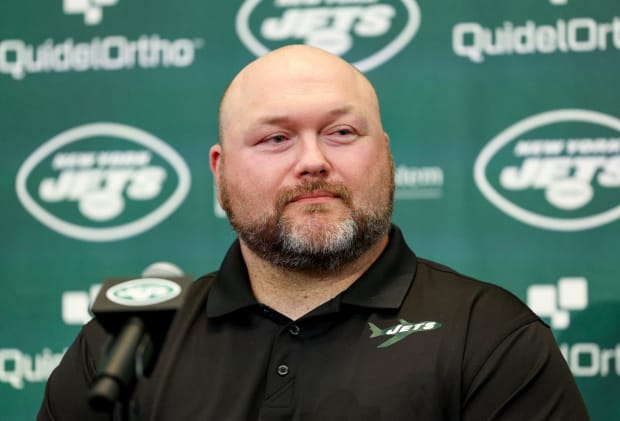
Elsa/Getty Images
The real deadline—the draft—was coming. While the Jets were willing to wait and go for as long as it took, they knew the Packers would be more difficult to deal with after the draft, when the idea of including a 2023 pick would be off the table. And they were right about that. Green Bay did view the draft as a real drop-dead date.
Still, even with the drops in communication, both GMs, with a relationship dating back to the turn of the century as old road scouts, had faith in one another, and their process, to ride out even the biggest bumps in the road.
So on Friday, April 21, Douglas reached out to a mutual friend and had that friend give Gutekunst a simple message: Let’s get this done. Gutekunst got back to Douglas via text, the two traded messages, then Gutekunst called and the sides worked through the weekend.
Johnson, and by extension the Jets, really didn’t want to give up a hard No. 1, and Gutekunst knew it. So, Douglas said, instead of the Jets’ giving up a hard No. 1 in 2024, and getting insurance in ’25 back, the sides should revisit melding the two ideas together—and going back to getting the Jets insurance on the first-round pick the Packers were insisting on.
The Jets had earlier proposed an AFC title-game protection (meaning the pick could be no higher than 29th), then a divisional round (no higher than 25th) or playoff (no higher than 19th) to trigger moving the pick from the first round to the second. By this point, they were down to tying it to a combination of play-time and wins.
But the Packers weren’t budging. While they were willing to give the Jets injury insurance, they wouldn’t move on the kind of performance insurance that left them shorthanded in the Favre trade 15 years earlier. And even then, there was some back-and-forth—Gutekunst wanted the play-time marker at 50%, and Douglas wanted it at 90%.
The two settled at 65%, and, to get the Packers to agree to come off the hard first-round pick, the Jets agreed to switch spots in the first round this year, with Green Bay jumping from No. 15 to 13 and New York going down two slots (which equated to giving up a low-third- or high-fourth-round pick on the teams’ draft-value charts). Gutekunst then agreed to send his fifth-round pick (No. 170) to the Jets for their sixth-rounder (No. 207) to give Douglas another win to take back to his owner.
Both GMs were uncomfortable with it Monday morning—Gutekunst because he didn’t get his hard first-rounder, Douglas because conditions on the first-rounder mandated only that Rodgers stay upright. But each guy knew how the other felt and knew the mutual discomfort was a sign that they’d reached a fair compromise.
Douglas was in a draft meeting with his staff and Saleh, in this one working with Saleh’s coordinators to set the Jets’ final board, when Gutekunst called with the final proposal. Douglas said he was good with it and told Gutekunst he’d go to Johnson and get right back to him.
Douglas called Johnson and, to start, told his boss that he wasn’t all that satisfied with the conditions on the pick. With that established, he made his pitch. They’re nowhere near what they first asked of us, Douglas explained. And ultimately, it’ll be good to get this done and get Aaron in the building with his teammates.
Sensing finality, Johnson got excited and signed off.
Douglas called Gutekunst.
You’ve got a deal, he told him.
Gutekunst told Douglas he’d send the trade papers, then walked back to the draft room and, knowing they still had to finish a contract adjustment with Rodgers and Rodgers still had to pass a physical, told his scouting directors, Jon-Eric Sullivan, Milt Hendrickson and John Wojciechowski, If we can get these other parts, I think we have a deal. At which point the group took a second, then got back to get their final look at the draft class’s cornerbacks.
Meanwhile, Douglas reentered his draft room in Jersey with a grin on his face and flashed a thumbs-up. The room exploded in applause.
We got our quarterback, Douglas told them.
Once the trade papers came, Douglas pulled his cellphone out of his pocket and took a picture, thinking about how wild it was, what the documents in front of him meant. And then he called Rodgers.
Hey bud, it’s done, Douglas said. You’re a Jet.
Figuring it would take until the first night of the draft to be traded—the revised contract would have to sit for a day, by rule, meaning it’d have to be done a day ahead of the second round—Rodgers reacted with a mild level of disbelief.
Really??
Of course, six weeks earlier, Douglas, Rodgers and their teams knew this would be the conclusion. Still, in the interim, Douglas kept reminding himself of how his bid for Tyreek Hill a year earlier fell through, despite the Jets’ best efforts, because Hill decided he’d rather be a Dolphin. And he knew letting things linger past the draft would put a similar result, if for different reasons, in play. So there’d be no victory lap until he got those trade papers in his hands.
Now, finally, he had them. Which meant his next Blanton’s would go down smooth. And, this time, he wouldn’t have to be so quiet with the celebration.
• How the Legendary 1983 QB Draft Class Changed the NFL Forever
• How Bryce Young’s Upbringing Shaped Him Into an Elite, Atypical QB
• A Different Kind of Team. A Different Kind of Adversity. Another Chiefs Super Bowl.







